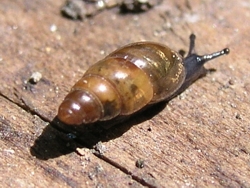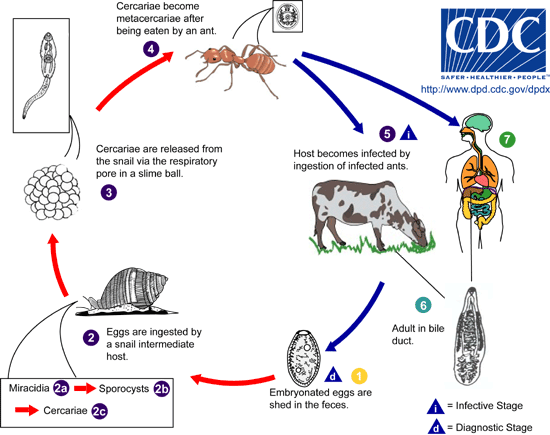Parasitic Behaviors of the Lancet Liver Fluke
Reed College - Biology 342 - Fall 2010
Genevra M. Kuziel
Ontogeny
The Stages of Development
- Miracidia -- free-swimming ciliated larval stage during which the transition from the eggs to the first intermediate host occurs.
- Sporocyst -- initial stage of infection in snails that can asexually produce more sporocysts.
- Cercariae -- free-swimming (flagella-like tail) larval stage during which the transition from the first intermediate host to the second intermediate host occurs.
- Metacercariae -- encysted cercariae during which the transition from the second intermediate host to the third definitive host occurs.
- Adult -- fully developed lancet liver fluke capable of reproduction; will live in the bile duct in the liver of the third definitive host until death.
Life Cycle of the Lancet Liver Fluke
First Intermediate Host: Terrestrial Snail (Cochlicopa lubrica in the United States). The miracidia are contained in the feces of the third definitive host and have not yet hatched. A snail eats the feces containing these embryonated eggs but does not kill them because the egg sacs are too tough to be digested [1]. Only when the miracidia have reached the intestine of the snail will they begin to hatch. The newly hatched miracidia then metamorphose into mother sporocysts in the digestive gland of the snail where they begin to produce daughter sporocysts. After several months have passed since the initial infection daughter sporocysts begin to release cercariae [11], which, in around 90 days, fill the mantel cavity (lung) of the snail. These cercariae irritate the mantel cavity’s delicate tissue, causing the snail to produce mucous in defense. All of this results in the snail coughing, expelling mucous balls full of hundreds of cercariae and leaving them in its slime trail. The cercariae are protected from desiccation by the hardening of the exterior of the slime trail as it dries [3].
Second Intermediate Host: Ant (Formica fusca in the United States). Ants gather the mucous balls as a source of moisture. Ants swallow the mucous, and consequently between 50 and 100 cercariae [11]. The cercariae bore holes in the crop (an enlargement of the esophagus) of the ant and close them with a special material so the ant doesn’t die. The cercariae end up in the gaster (the bulbous posterior portion of the metasoma, which is the posterior part of the body) of the ant, where metacercariae begin to develop [6]. One of the metacercariae encysts in the subesophageal ganglion of the ant, which is composed of three pairs of fused ganglia and controls certain muscles, altering the behavior of the ant. Instead of returning to its mound at night the ant climbs a blade of grass or other vegetation and cling to it using its mandibles, while still behaving “normally” during the day. This only happens between dusk and dawn because the host and parasites would die if exposed to the heat of direct sunlight and the ant still needs to eat for both to survive. As the ant sits atop the blade of grass it is perfectly poised to be accidentally eaten by a grazing animal. This process will continue night after night until just such an event occurs [3]. An ant can live “normally” for at least a year in this condition [6].
Third Definitive Host: Cattle, Sheep, Other Grazing Mammals. Once the ant, and therefore the metacercariae, are ingested, the metacercariae excyst in the duodenum (the first part of the small intestine immediately beyond the stomach). These juveniles penetrate blood vessels and travel up the common bile duct to the capillaries of the liver. They then bore through the walls of the capillaries and migrate to the bile duct in the liver where they proceed to soak up nutrients from the host and will continue to do so for the rest of their lives [6]. Once in the bile duct and liver, adults mature in 6-7 weeks and will remain there until death [3]; typical infections may be tens of thousands of lancet liver flukes. Embryonated eggs are produced about 10-12 weeks after infection [12]. These eggs then pass down the common bile duct to the intestines and, once excreted in the feces of the host, will start this cycle all over again [2].


